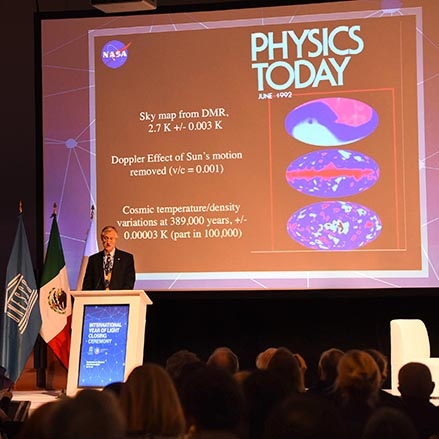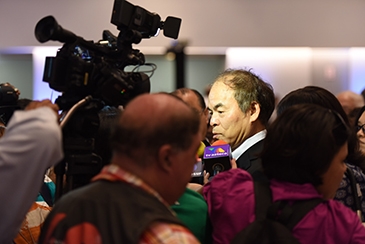The International Year of Light Ends
Hundreds of scientists, politicians, artists, humanitarians, and journalists gathered last week for a three-day ceremony in Merida, Mexico, to mark the official end of the International Year of Light. Sponsored by the United Nations, the yearlong event sought to celebrate light in art and science around the world and to raise global awareness of the role optics and photonics are playing in new medicines, technologies, paths toward environmental sustainability, and innovative ways of addressing light poverty and other disparities in poor, rural places all over the world.
IYL2015, as it came to be known, kicked off a year ago in Paris. AIP sent a delegation to Paris and another to Merida. Also at the closing ceremony were delegations from APS and The Optical Society (OSA). AIP, APS, and OSA are all founding partners of IYL2015 and helped organize elements of the yearlong event. A complete list of sponsors can be found here: http://www.light2015.0rg/Home/About/Sponsors.html.
What we found when we got down to Mexico was a hot, sticky, historic, and beautiful spot bathed in all kinds of light. At night there were walk-through LED displays tourists delighted in taking pictures next to. We saw a movie projected onto a patch of the nearby museum so long that you could fit the entire screen into your field of vision. And the final night of the ceremony featured two archaeoastronomy lectures on site at Chichen Itza followed by a light show projected directly onto the great Castle Pyramid. Watch part of that light show https://youtu.be/aqpr6RIeXYo.
A Land of Extinction and Sacrifice
Merida is the capitol of the modern Mexican state of Yucatán, but it is an ancient city—one of the oldest in North America. It was once the center of Mayan civilization, and it was not hard to imagine what living there would have been like then because we drove through miles of it on our way to Chichen Itza—thick, green forests of short, scrubby trees.
The city is located within the Chicxulub crater, where a massive, 6-mile-wide asteroid pounded into the nearby coastal waters more than 60 million years ago and set off one of the biggest explosions and megatsunamis the world has ever seen, a natural disaster of unimaginable proportion that ended life on earth as it was known then. The dinosaur-dominated Cretaceous period ended not with a whimper but with a bang, with mass extinctions around the globe.
Millions of years later, this apocalyptic horror is what actually gave life to Mayan civilization, one of the flowers of pre-Columbian cultures. The sedimentary basin that formed in this impact is coastal and has one unusual feature: karst sinkholes, which had become natural aquifers by the time the first humans arrived, now dot the Yucatán landscape. They were what made massive farming communities possible in what was otherwise an inhospitable water-scarce climate.
Ironically, the Mayans repaid the gods every year with a gift of human sacrifice—mostly children, as my tour guide of the Chichen Itza site took pains to explain.
“Yes, is true,” he said with an odd mix of acceptance and shame.
Looking Back

At the beginning of the ceremony, we were greeted with slightly rosier messages from dignitaries, including UN secretary general Ban Ki-moon, who sent a personal note commemorating IYL2015. We were also greeted by Rolando Zapata Bello, the governor of the state of Yucatán.
The governor was beaming, surrounded by cameras, and this was clearly a favorable spot for him. “The land of the great Mayan culture is honored to have all of you here,” he told the crowd with a politician’s blustery largess. Then he spoke of his signature education and innovation initiatives while bathed in paparazzi strobes.
It was Bello who formally declared the year to be at an end. At the event the evening before, a VIP reception at the governor’s palace, he issued and cancelled the first stamp in a series his government was offering to honor IYL2015—one of several commemorative stamps and coins issued in different countries in the past year.
Mostly, IYL2015 was a year made up of hundreds of events, big and small, that were held in 148 countries all over the world. Some flooded famous monuments with light. About 16,000 build-it-yourself Galileoscopes were distributed. There were countless conferences, lab tours, webcasts, and school activities. Some featured original musical compositions. Some were captured in one of the 70 videos and films produced during the year and shown at a special film festival during IYL2015, including one by AIP.
Watch our entry here: https://www.youtube.com/watch?v=54XWR-J02Ms.
Last summer, the major US celebration was held in the United States in twin events sponsored by the National Science Foundation, the National Academies, and many of the founding partners including AIP, APS, and OSA.
Read about “Wonders of Light: Family Science Fun,” which was at the Smithsonian’s National Museum of the American Indian, here: http://light2015blog.org/2015/09/25/huge-success-for-wonders-of-light-a-cornerstone-u-s-iyl-2015-event/.
Read about “Light for a Better World: A Celebration of U.S. Innovation,” which took place at the National Academy of Sciences building, here: http://light2015blog.org/2015/09/17/light-for-a-better-world-a-celebration-of-u-s-innovation-at-the-national-academy-of-sciences/.
IYL2015 was also a celebration of history, and several talks were devoted to famous figures like the ancient Grecco-Egyptian astronomer and mathematician Ptolemy as well as the famous Arabian scientist Ibn al Hytham, who is considered to be a father of modern optics. We also heard about a fascinating if lesser known figure named Mo Zi, who did important work on the subject 2,500 years ago in China.
The Modern Light
The year was also a celebration of the best optics and photonics has to offer today. During the conference, Sir David Payne of the University of Southampton in England presented John Dudley, one of the chief organizers of IYL2015, with a very special piece of silicon. Inside the material was a tiny 5D laser etched copy of the UN Declaration of Human Rights. This was an example of a very new, polarization-encoded storage technology Payne said would last 100,000,000,000,000,000,000 years.
That was not the only celebration of the technologies of tomorrow. Payne estimated the world photonics market would be worth $615 billion by 2020.
2014 Nobel laureate Shuji Nakamura gave the opening plenary lecture about LEDs, and he predicted they would play a major role in reducing power consumption on a societal level. By 2020, he estimated, some 19 nuclear power plants in the United States, 17 in China, and seven more in Japan would be made redundant by LEDs. The next day 2006 Nobel laureate John Mather spoke about astronomy and the next-generation James Webb telescope.
A Brighter Tomorrow
In the end, the brightest hopes for the future came through the words of those whose work over the last year has been devoted to helping many different people who were most in need.
Jorge Avila Treviño from Philips spoke about light poverty and the millions and millions of people who live off the grid and cannot light their homes. In all, some 1.5 billion people worldwide live without electricity. “Human suffering on this scale is unacceptable in the 21st century,” he said.
Another speaker was Olivia Otieno, the head of marketing and development for SunnyMoney, which sets up entrepreneurial ventures to sell inexpensive LEDs in Africa for the purpose of lighting homes at night. Currently many homes rely on inefficient, polluting kerosene lamps, which are a fire hazard, a health hazard, and an expensive fuel suck.
“Just imagine what you could do with 25 percent of your monthly income if you were not using it for lighting purposes,” said Otieno.
Stories like that gave me hope, and it was nice to see firsthand how the work we do here at AIP and in collaboration with the Member Societies is part of a community of efforts aiming to a brighter future for all humanity. That’s no empty boast. In their welcoming remarks in the program handed out to participants, closing ceremony organizers John Dudley and Ana Maria Cetto reflected this very sentiment:
It is sometimes difficult to see how we as individuals can contribute to solving issues of global importance, but we hope that the International Year of Light has provided a timely reminder that through our commitment to education and outreach, we can really make a difference. We can be proud of what we have achieved together, but let us look forward to maintaining the partnerships developed during the International Year of Light and continuing to work together for the betterment of all.


